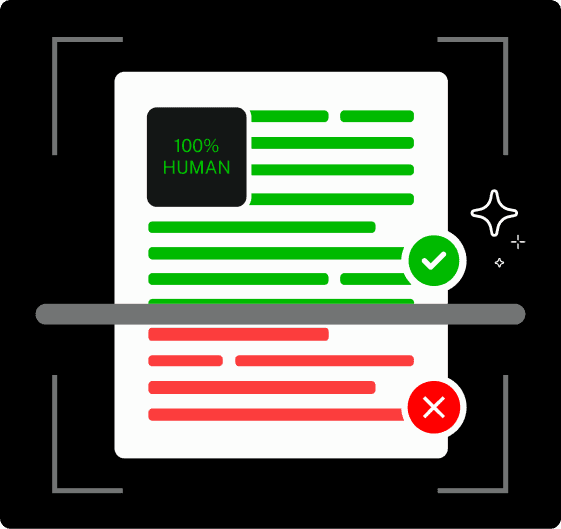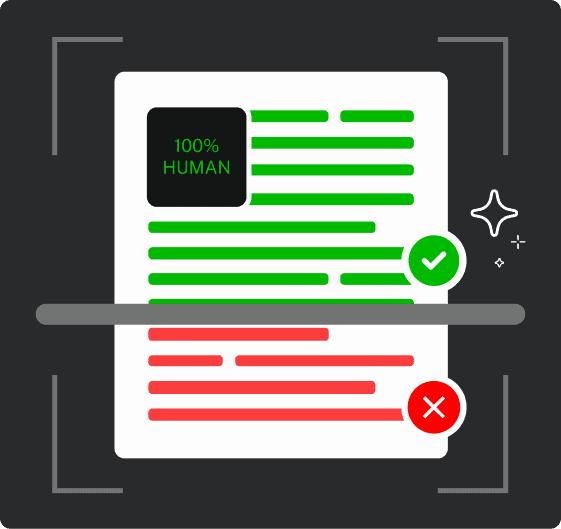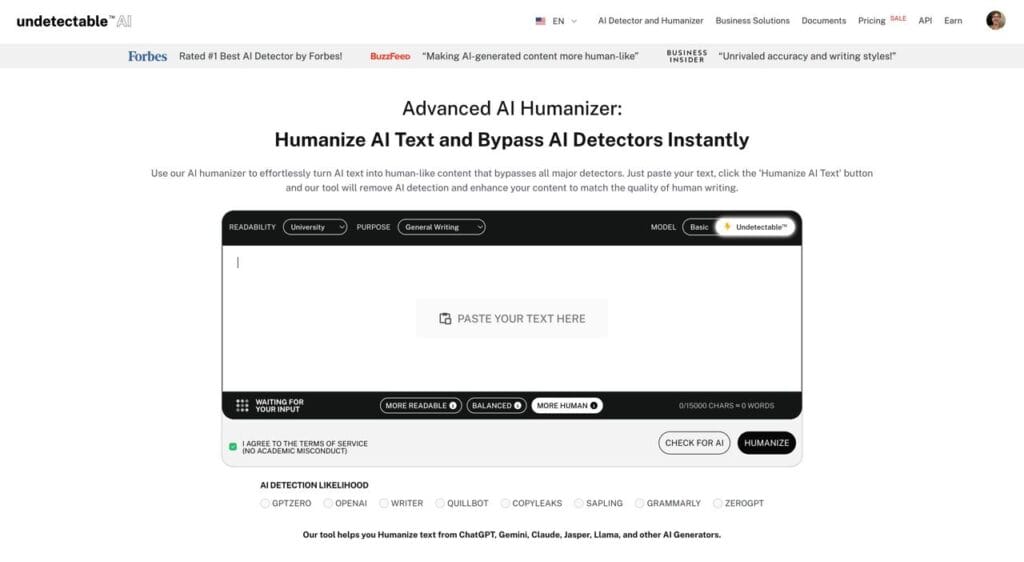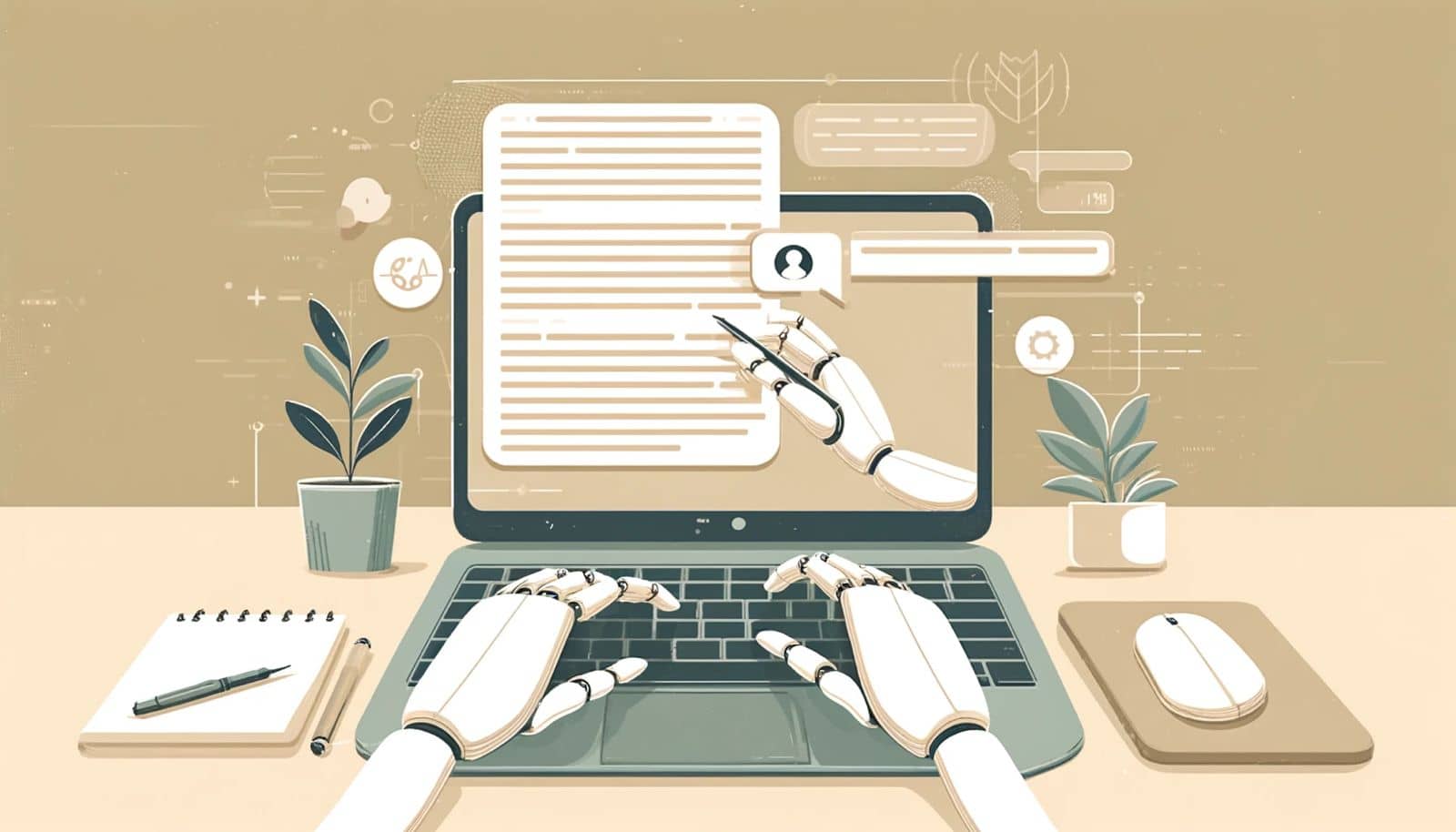Everything changed in 2022 for writers when OpenAI released its ChatGPT language model. It seemed like a flip was switched overnight.
Now, anyone with access to an AI writing tool could pump out AI-generated content in a matter of minutes.
As websites and schools began to clue into the rising use of AI, a new question was asked: how to avoid AI detection?
AI detector tools were introduced shortly after the launch of ChatGPT and were quickly adopted by everyone from Google SEO to Universities.
So is it possible to avoid AI detection? Absolutely.
The key to utilizing AI and avoiding AI detection is to ensure that your content is humanized before submitting it.
This article will discuss what exactly AI detection is and the steps you can take to avoid AI detection when using an AI writing tool to generate content.
What is AI detection?

AI detection is the act of scanning text to determine the probability that it was created by AI or a human writer.
The key word in this is probability: AI detection should never be used as a true confirmation that the text was generated by an AI writing tool like ChatGPT.
If that sounds confusing, let us explain.


Never Worry About AI Detecting Your Texts Again. Undetectable AI Can Help You:
- Make your AI assisted writing appear human-like.
- Bypass all major AI detection tools with just one click.
- Use AI safely and confidently in school and work.
When your text is scanned by an AI detector, it searches for predictable patterns that are known to appear in AI-generated text.
The detector itself is not reading the text and determining if it sounds like it was created by a computer or a human.
Most of these patterns are apparent in the structure of the text.
Things like syntax, sentence length, and word choice are all tell-tale signs that the text was written by AI.
However, AI detectors are infamous for providing false positives.
In this case, that would mean the text was written by a human but is being flagged as written by AI.
When AI detectors scan the text it will provide an AI detection score.
This score is typically provided as a percentage.
An AI detection score of 50% does not mean that half of your content is being flagged as AI-written.
This score indicates that there is a 50% probability that the content was created by AI.
Why Avoid AI Detection?
This has always been a controversial topic of discussion. Why avoid AI detection?
The group that asks this question the most is likely students who are seeking out a way of submitting AI-generated assignments.
Universities worldwide have started to use AI detectors through sites like TurnItIn.com and have been severely punishing students whose assignments are flagged as generated by AI.
Students need to have their work pass the AI detector for it to be accepted by the University.
Content creators and bloggers have also been keen on avoiding AI detection because of concerns over negative impacts on SEO rankings and ad revenue.
As you’ll see in this next section, this might not even be necessary!
Can Google Detect AI Content?

Yes, Google can detect AI content on websites and blogs. Did you think that the largest search engine in the world wouldn’t be able to scan for AI content?
The question isn’t whether or not Google can detect AI content, it’s “Does Google even care?”.
As of now, it does not seem that Google cares. In fact, in its latest SEO guidelines, Google states explicitly that it does not penalize sites for posting AI-generated content.
As a content creator, you are free to pump out AI-generated articles to your heart’s content.
There is a caveat though: Google’s EEAT guidelines will penalize content that does not offer first-hand experience or direct expertise on the subject.
This can have an impact on a site’s SEO ranking which would directly affect things like ad revenue and potential affiliate sales if there is lower traffic.
Google will also penalize your content if it violates its spam guidelines.
Understandably, Google uses some pretty state-of-the-art technology to scan for AI.
Through machine-learning algorithms that can learn to detect AI content even as the technology continues to evolve.
Google does not care if the content is AI-generated. Google just wants content to be high-quality and not considered to be spam.
Is it Possible to Avoid AI Detection?
Yes, it is possible to avoid AI detection when you use AI-generated content.
While we would never condone avoiding AI detection for academic dishonesty, there are plenty of tools out there to bypass AI detectors.
Using these tools to alter or scramble your AI-generated content is the best way to avoid detection. Remember, AI detectors are just searching for patterns in the writing.
Let’s take a look at some writing techniques you can use to avoid having your content flagged as AI-generated.
What are the techniques to avoid AI detection?
The best ways to avoid AI detection involve adding your human touch to the text.
Breaking up the structure and using different words can help provide a lower AI detection score.
The key to avoiding AI detection is understanding what these detectors are looking for.
Here is our list of the best techniques to use to avoid AI detection.
Use Natural Language
For now, AI writing tools like ChatGPT will default to an informative writing style.
While that is fine for asking questions, it isn’t that interesting for most readers.
Using a more natural, conversational language will not only increase your readability score but will throw off AI detectors.
Use Descriptive Prompts
A prompt is an order, question, or request that you input into an LLM like ChatGPT to provide an output or response.
It has been proven that providing description prompts with context can assist in providing a more realistic output.
Prompt engineering is the skill of creating better, more contextual prompts which will help the platform learn what you are expecting in response.
The general rule of thumb is: that the more detailed and descriptive your prompts are, the better your responses will be.
Avoid Plagiarism
This seems like a no-brainer for any writer but it needs to be said. AI writing tools do have the potential to generate plagiarised work.
Quite a few AI detection tools will also scan for plagiarism as well.
Plagiarism is already a heavily penalized offence for students and content creators.
It adds another wrinkle when AI writing tools can occasionally produce text that has been plagiarised from another source. Always check your work before you submit it!
Use Editing Tools
There are a lot of editing tools that can be used to improve the grammar and syntax of your text. In other words, editing your AI-generated text to sound less robotic and mechanical.
Some tools, like Quillbot, will take your AI text and paraphrase it, although that doesn’t work as well when you want a blog post or an article.
Other tools like Grammarly are simpler forms of AI and help to provide you with a more natural delivery while improving your text’s readability.
Use Human-Written Content
What is the one sure way to avoid AI detectors? To use human-written content!
You don’t need to re-write the entire article, but human editing and re-writing are some of the best ways to avoid detection.
This involves re-writing AI text using a better structure and syntax than the original output.
Adding in human-written content is also one of the more recommended ways to harness the power of AI without getting flagged.
Vary Your Writing Style
If you are writing your content yourself make sure to vary your writing style.
Why? Because having a mechanical and predictable writing style is a sure way to get flagged as a false positive for AI-generated content.
Use Specific Examples and Details
As intelligent as AI is, it tends to shy away from mentioning specific details and personal experiences.
This probably has to do with the fact that AI does not have any personal experiences to draw from.
When editing your AI content, add in as much detail and examples as you can because this is one thing about human writing that is absent in AI writing.
Those human nuances are what distinguish your content as being not written by AI.
Be Creative and Original
The one advantage that we have over AI, for now, is our creativity. Be original, not just with your content but with your writing style.
It’s easy to understand this concept once you’ve read a few AI-generated articles.
They can be pretty dry and robotic, which makes sense considering they were written by a computer.
The more creativity and original content you can add to enhance the AI-written text, the less likely it will be flagged as AI content.
Humanize Your Content Using Undetectable.AI

If that seems like a lot of work, you’re right it is. High-quality content takes time and effort and that’s why AI writing tools should be used to enhance your content, not replace it.
If you want to check out one tool that does all of the above with the click of a button, we recommend Undetectable.AI, the tool that humanizes AI writing.
With Undetectable.AI, you can paste your AI or human-generated content and “humanize” it.
What does humanizing content mean?
It means that when you take the output from Undetectable.AI and scan it with an AI detector tool, it will not get flagged.
Undetectable.AI is the leader in AI content scrambling and has a strong pass rate against the likes of GPTZero, CopyLeaks, and Sapling.
The best part about Undetectable.AI? It won’t cost you an arm and a leg like other AI tools.
You can scan up to 10,000 words for as little as $9.99 per month or $5.00 per month if you pay annually.
Ready to see the difference? Test the Undetectable AI widget below and experience firsthand how it can enhance your writing (English only).
Just input your text and watch as it transforms into a more humanized and polished version. Give it a try now!
When Should You Avoid Using AI?
AI is an incredible tool to enhance research and content creation. But there are times when it is just not worth it to use AI to do the job.
Whether it is for ethical reasons or security and privacy, sometimes you just need to avoid using AI and finish the job yourself!
Complexity and Personalization
As we mentioned, when it comes to adding the creative human touch to your work, you’re better off doing it on your own. The same applies to visuals—AI Image Detector can help identify AI-generated images, ensuring authenticity in content creation.
To meet the level of complexity that is necessary for high-quality content, it usually requires a human edit.
One of the foundations of AI is something called perplexity. This refers to the complexity and readability of text.
AI-generated text has a low level of perplexity as the tool is usually programmed to not confuse human readers. If you want a more complex text, skip the AI tools and make the edits yourself.
Liability and Accountability
Anytime there might be a liability for the text that you are producing, it’s better to take the risk out of the equation and not use AI.
Why? Because AI writing tools do not take into account that there might be liabilities or security risks in the content they are creating.
Inaccurate or Outdated Information
You might be wondering why inaccurate or outdated information might be included in the content.
Well, if it is AI-generated, there is a higher chance that factual inaccuracies, also referred to as AI hallucinations will be included.
AI works better when it is given a larger amount of data to work with. You should not rely on it to be factual and accurate because it all depends on the datasets with which it was trained.
Ethical Considerations
Remember, if you’re a student using AI to do your assignments or even a content creator trying to pump out unhelpful and boring articles to make more revenue, think twice about using AI.
Academic dishonesty from using AI can get you suspended or even expelled from your school.
Using AI to complete a job task for your employee can also get you in trouble at work. Is it worth it? Nope!
What are the examples of content that can be detected as AI-generated?
What gives it away that content has been created by AI? Anyone who has read a completely AI-generated article should be able to tell, especially if the article hasn’t had any human intervention.
The text will read robotically with the same recurring sentence structure and length.
If you notice the same word choices and vague descriptions as well, that is usually a dead giveaway that the text wasn’t written by a human.
There is also the unquantifiable factor of AI writing: it’s missing that human soul and connection. If you or I were to write something we’d include things like nuance and human experiences.
At this stage, AI is unable to re-produce these things in its writing. For now, human writers still have the upper hand over our AI counterparts.
What are the tools to avoid AI detection?
The tools we covered in this article are just the tip of the iceberg. AI scrambling tools like Undetectable.AI are the most efficient way to avoid AI detection.
Not only can these bypass detectors, but Undetectable will save you time that would have otherwise been spent editing and re-writing your AI content.
Other tools include AI paraphrasers like QuilBot which can take a large amount of text and paraphrase it into a smaller output.
Note that QuillBot does not necessarily guarantee that the output avoids AI detection as Undetectable does.
Conclusion
When ChatGPT launched in November 2022, the writing industry changed forever. Not only is AI being used to enhance writing but some are even trying to replace human writing altogether.
For those people, the final barrier is being flagged by an AI detector for submitting AI-generated content as their own.
Is it possible to avoid AI detection? Of course! You can either put the time and effort into editing it or you can get a tool like Undetectable.AI to humanize that text for you.
Either way, AI detection can be avoided but only do so if it is ethically acceptable for you to do so.
Human writers are still capable of producing better and more readable content than any AI writing tool on the market.
